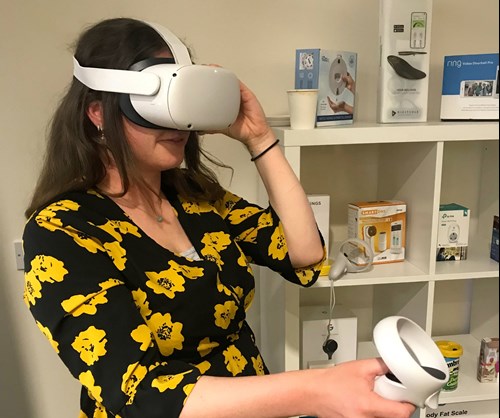How smart tech is empowering people at home
In May, the West Essex Community Action Network (WECAN)’s Living Smart Home project launched a demonstration shop to show how smart home technology can people to feel safer and more independent in their own homes.
The shop, located at the Harvey Centre in Harlow, allows people to see smart technology in action, including VR headsets, fridge sensors, ring doorbells and smart bulbs. In addition, the Living Smart Home project has five hosting homes, where smart tech is being used by real families to help support their health, wellbeing and independence, from the comfort of their own homes.
The project is benefiting dementia and stroke patients, families with children with learning disabilities, and elderly people who are vulnerable and isolated. In addition, healthcare professionals – such as community nurses – can track their patients’ health using some of the smart tech available.

Superfast Essex's communications manager Lois Harris tries out a VR headset at the event.
Independence at home
One of the hosting homes belongs to a 40-year-old mum who recently suffered a stroke. Thanks to smart technology, including a robot vacuum cleaner, she now feels she has control over her own home. Other technology which can help people to feel more independent at home includes:
- Memory tiles – these provide reminders such as remembering to turn the heating off or can be added to the top of food products to remind the person of when the item was opened.
- Fridge and freezer sensors – these go off when a fridge or freezer door has been left open.
- Smart bulbs – these motion-sensor bulbs light up the home at night to reduce falls.

Gadgets like these can be added to the top of food items with a recorded message so the person can remember when it was opened, for example.
Reducing loneliness
A robotic cat – which looks, feels and sounds like a real cat – has made a real difference to the life of a dementia patient, who was no longer able to have a pet.
Virtual reality (VR) headsets, which offer a 360-degree experience, are increasingly being used to combat loneliness or in cases where people have limited mobility and are unable to leave the house. Examples include going on a virtual walk along the coast or in woodland, or even visiting a place where the person once went on holiday.

Increasing safety
In addition to smart technology helping people to feel safer in their own home, there are also devices on offer to reassure family members that their loved ones are safe, including:
- Ring doorbells, which can be used to monitor visitors.
- GPS smart soles, which are inserted into shoes and can track movements.
- Personal identification from OneLife iD.
Health and wellbeing
There’s a wide range of technology to help track people’s health, including:
- Pill dispensers, which send an alert when medication has been dispensed.
- Smart thermometers, which can be accessed remotely to check the person’s home is at a safe temperature.
- The Aquarate beaker, which monitors how much a person is drinking and shows if they are not drinking enough.
- Diabetes tech, including the FreeStyle Libre 2 flash glucose monitoring system.
- Bluetooth-enabled medical equipment, including blood pressure monitoring machines.
To find out more about the technology available via the Living Smart Home project, visit the WECAN website.